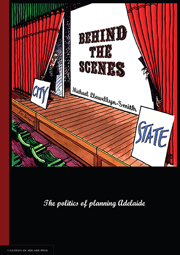Book contents
- Frontmatter
- Contents
- List of Figures and Tables
- Abbreviations
- Acknowledgements
- Foreword
- Introduction
- 1 The background to the founding of Adelaide and South Australia in 1836
- 2 The development of the City and State from 1840 until 1950 and the City/State relationship during this period
- 3 Changing attitudes to planning the City and State from 1950 until 1972
- 4 The establishment of the City of Adelaide Development Committee and the introduction of Interim Development Control
- 5 Planning in Sydney and the work of George Clarke
- 6 The City of Adelaide Planning Study
- 7 Converting the City of Adelaide Planning Study into a City Plan
- 8 An innovative system of city planning from 1 March 1977
- 9 Changes in the ACC and the State, and the first Heritage Study of the City
- 10 The operation of the City's planning system from November 1982 until May 1987
- 11 The Condous Lord Mayoralty and the declining importance of the City of Adelaide Planning Commission
- 12 The State Planning Review, the last City Plan and the end of the City's separate system
- Conclusion
- Appendix 1 Key People of Influence identified as potential interviewees
- Appendix 2 Heritage Summary Assessment Sheet
- Bibliography
- Index
7 - Converting the City of Adelaide Planning Study into a City Plan
Published online by Cambridge University Press: 05 June 2013
- Frontmatter
- Contents
- List of Figures and Tables
- Abbreviations
- Acknowledgements
- Foreword
- Introduction
- 1 The background to the founding of Adelaide and South Australia in 1836
- 2 The development of the City and State from 1840 until 1950 and the City/State relationship during this period
- 3 Changing attitudes to planning the City and State from 1950 until 1972
- 4 The establishment of the City of Adelaide Development Committee and the introduction of Interim Development Control
- 5 Planning in Sydney and the work of George Clarke
- 6 The City of Adelaide Planning Study
- 7 Converting the City of Adelaide Planning Study into a City Plan
- 8 An innovative system of city planning from 1 March 1977
- 9 Changes in the ACC and the State, and the first Heritage Study of the City
- 10 The operation of the City's planning system from November 1982 until May 1987
- 11 The Condous Lord Mayoralty and the declining importance of the City of Adelaide Planning Commission
- 12 The State Planning Review, the last City Plan and the end of the City's separate system
- Conclusion
- Appendix 1 Key People of Influence identified as potential interviewees
- Appendix 2 Heritage Summary Assessment Sheet
- Bibliography
- Index
Summary
CITY/STATE NEGOTIATIONS
The Whitlam Federal Government was dismissed on 11 November 1975. At the time, John Mant was Whitlam's Principal Private Secretary, although technically Mant was an Assistant Secretary in the National Capital Development Commission (NCDC). Mant had got to know Hugh Hudson when Hudson was the South Australian Minister for Education and visited Canberra to see the Prime Minister and others about educational projects in South Australia. Mant resigned with the change of federal government, intending to return to Sydney and set up a law practice. But Hudson invited Mant to become an advisor in South Australia, as Hudson had become the Minister for Planning. Mant reflected:
I accepted the offer and moved to Adelaide where my principal task was to advise Hudson on how to deal with the City of Adelaide Plan which had been adopted by the Council and which the Council expected to become law.
A period of intense negotiations to finalise the plan and legislation that would be acceptable to both the State and the ACC then began. During this period of negotiation, the ACC decided to advance some of the action projects and programmes that George Clarke and USC had recommended. As the City Planner I invited the Town Clerk and all the Heads of Departments (the Executive Committee of the ACC) to participate in the action projects where they had an interest and to nominate a staff member for the relevant project team. The co-ordination of the action project programme was delegated to Gilbert Currie, the Deputy City Planner.
- Type
- Chapter
- Information
- Behind the ScenesThe politics of planning Adelaide, pp. 197 - 206Publisher: The University of Adelaide PressPrint publication year: 2012



